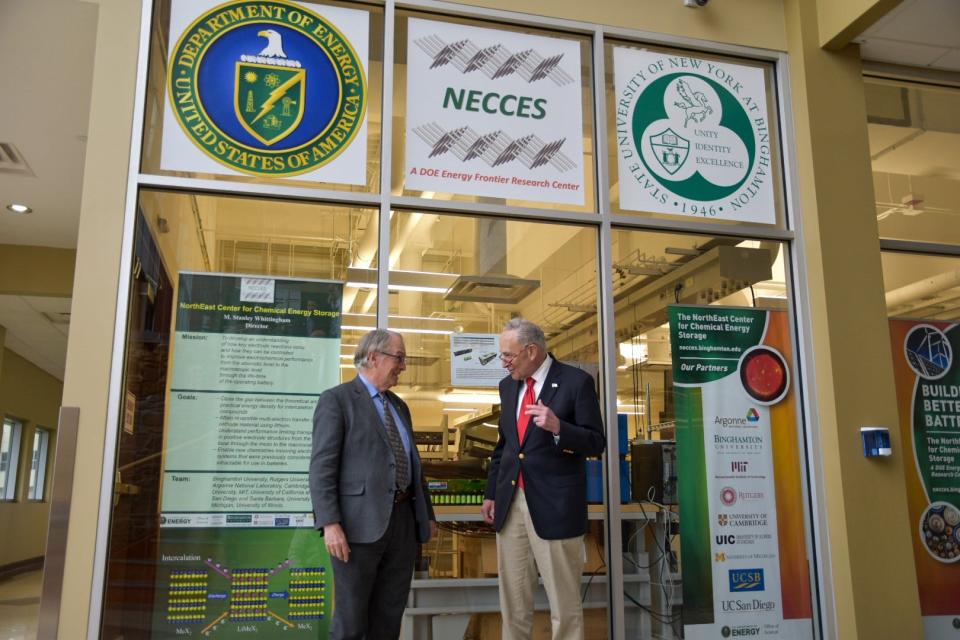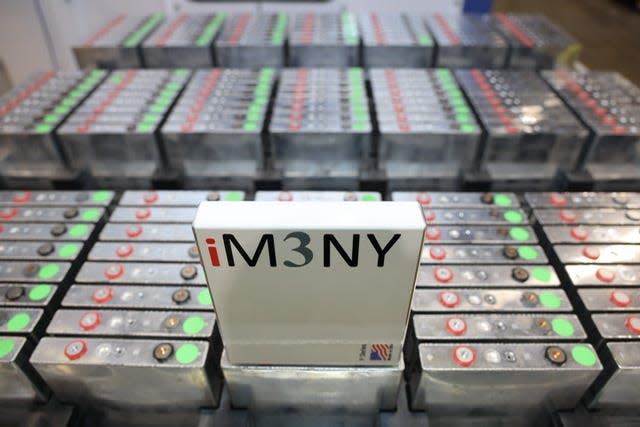Another $160 million to grow Binghamton's battery industry? BU targets new NSF funding
Binghamton University is aiming to bring another game-changing grant home to the Southern Tier.
BU’s New Energy New York project has cleared a major hurdle and advanced to the next round of consideration for up to $160 million in the National Science Foundation’s Regional “Innovation Engines” Competition.
The winners will be announced this fall, about a year after Binghamton was awarded nearly $114 million in state and federal grants to turn the region into the nation’s premier hub for lithium battery research, manufacturing and workforce development.
Senate Majority Leader Chuck Schumer (D-NY) said he is launching “an all-out push” to secure the award for Binghamton.
“Binghamton is quickly becoming the beating heart of innovation for America’s battery belt, and now because of my CHIPS & Science bill, the Southern Tier has the chance to supercharge its rapidly growing battery hub,” said Senator Schumer. “Batteries are the building blocks of modern technology and the lynchpin of the transition to a carbon-free economy.
“That is why I personally wrote the NSF Director, Sethuraman Panchanathan, that Binghamton University is ready to lead the charge in creating thousands of good-paying jobs, fueling innovation to combat climate change, and bringing this industry back to America.”
What’s next for BU’s application?

The NSF Engines competition received upwards of 200 initial applicants. BU’s project was among just 34 selected for a site visit by the NSF in the next round of the competition.
The NSF Engines funded this fall can receive up to $160 million over a 10-year period. Projects will be assessed annually, with funding levels dependent on overall progress. Each awardee is guaranteed about $15 million the first two years to kickstart its work.
Binghamton’s New Energy New York project includes a coalition of partners in the Southern Tier and Finger Lakes working towards growing the region’s battery economy.
“We have depth and breadth when it comes to academic researchers, workforce development experts and industry professionals,” said Per Stromhaug, BU’s associate vice president for innovation and economic development. “With Senator Schumer and his team supporting us, we are confident we can transform our region, attract investment, create new jobs and fill those jobs with a skilled workforce.”
How did Binghamton University get here?

The NSF award would build on the 2022 grant money, which included $63.7 million from the American Rescue Plan’s Build Back Better Regional Challenge and a $50 million match from New York state. That money will support projects centered around workforce and supply chain development, innovation, and the creation of Battery-NY, a Battery Technology and Manufacturing Center hosted by Binghamton University.
“We’re proud of the Binghamton team that keeps working to make our region the epicenter for advancing battery technologies as well as the manufacturing hub of those batteries,” said BU President Harvey Stenger. “It’s imperative that the United States domesticates its battery supply chain, and federal efforts to support our work to make that happen are crucial.”
More: How did Binghamton University land $113M battery bonanza? Here's the backstory
Binghamton’s prominence in the industry can be traced to Distinguished Professor M. Stanley Whittingham, who won the 2019 Nobel prize in chemistry for his critical role in developing lithium-ion batteries.
A Whittingham protege, Shailesh Upreti, chairs iM3NY. The company recently started commercial production of lithium-ion battery cells on the Huron Campus, the original home of IBM. The company is seeking a $700 million loan from the Department of Energy to power its growth in Endicott, which it estimates will create around 8,000 jobs in the industry.
More: What's next for $113M Binghamton battery project? What to know about timelines, impacts
How would the $160 million be spent?
The NSF Engines competition is a new program created through the CHIPS and Science Act passed in 2022. It aims to fuel American innovation and job growth in key technologies like batteries, semiconductors and artificial intelligence.
Schumer said New Energy New York will create a full battery technology lifecycle ecosystem in Upstate New York. The NSF Engines funding would capitalize on programs already underway in the region, while aiding the launch of new initiatives to strengthen the nation’s battery supply chain.
“Domestic production of batteries and a secure supply chain are critical to U.S. and North American global competitiveness and economic stability as well as key to reaching climate goals set by New York state and the federal government,” said Whittingham. “NSF Engines funding will propel our nascent ecosystem from growth to maturity, fueled by the foundational 2022 EDA Build Back Better Regional Challenge New Energy New York initiative.”
This article originally appeared on Binghamton Press & Sun-Bulletin: Binghamton university seeks $160 million Innovation Engines funding
